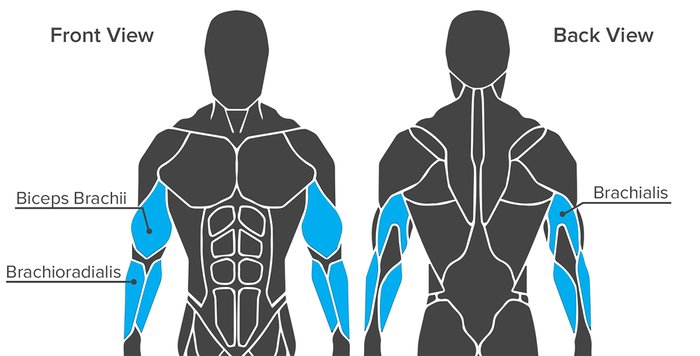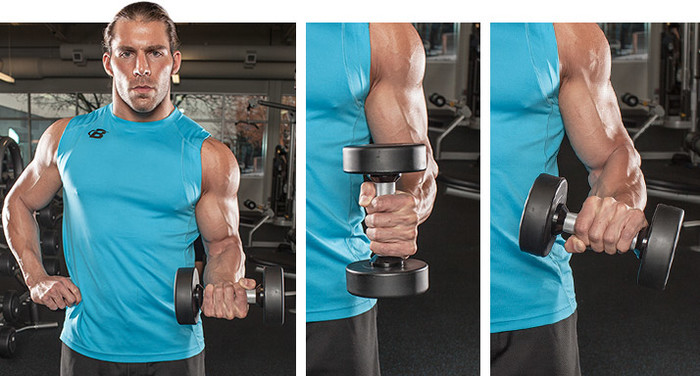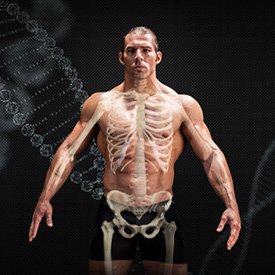Muscle Growth | Arms | Legs | Back | Chest | Shoulders | Core
Guys and girls alike want a killer set of arms. Why? Do you really have to ask? Because they're one of the most impressive and visible muscle groups on your body. There's a reason you can't walk into a gym without seeing at least one person doing biceps curls.
Sure, building arms isn't rocket science, but it is science! To train your arms most effectively, you need to understand how they're put together. Details like muscular attachment points, different grips, and specific positions can make a profound difference on your growth. Here's what you need to know about the muscles in your arms to get the best results from your training.
Muscular Anatomy: Biceps
To train the front of your arms, you need to focus on three specific muscles: the biceps brachii, the brachialis, and the brachioradialis. The differences in these muscles are important to note.
Biceps Brachii: Biceps means "two heads." Your biceps muscles include a short head, which originates at the front of your scapula and inserts at top of the radius (the forearm bone that ends near your thumb), and a long head, which also originates at the scapula but takes a longer route to insert on your radius.
Brachialis: The brachialis runs from the midpoint of your humerus (your upper-arm bone) to your ulna (the forearm bone that ends near your pinky finger). Because it does not insert on the radius, the brachialis does not help pronate or supinate your arm. Its main role is to help flex the elbow.
Brachioradialis: Your brachioradialis is a long forearm muscle. It originates on the humerus and attaches at the end of the radial bone.

Muscular Anatomy: Triceps
Most beginners focus on biceps because they pop when you flex, but your triceps brachii make up the majority of your upper arm, so it's important to give them just as much attention. Triceps means "three heads." You need to train each head of your triceps to get that horseshoe shape.
Lateral Head: The lateral head of your triceps originates on the upper humerus and attaches at your elbow, or what's known as the olecranon process.
Medial Head: The medial head starts on the back side of the humerus and attaches to your elbow.
Long Head: The long head runs from your scapula and attaches at your elbow. Because it attaches on the scapula, you can move the arm and shoulder to isolate it (as discussed in more detail below).
Muscle Function
As you begin to understand the different shoulder and elbow positions, you'll learn how to maximize your arm growth and get more out of each training session.
Supinated Grip: The biceps brachii help create flexion and supination. To target the biceps brachii most effectively, you need to use a supinated grip.
Neutral Grip: As soon as you go into a neutral grip, like in a hammer curl, you have a direct line of pull and will maximize development of the brachialis. This can also make your biceps appear bigger by "pushing" them up from below.
Pronated Grip: A fully pronated grip loses the mechanical advantage of the biceps, giving you a direct line of pull to the brachioradialis. When you're doing a reverse curl, you're isolating this muscle, which can help add size to both the upper arm and forearm.

Elbow Extension: When you go from a flexed to an extended elbow position, you're working all three heads of the triceps equally. This is what happens on classic triceps moves like push-downs.
Overhead Elbow Extension: As soon as you move the weight over your head, you start to preferentially recruit the long head of your triceps.
The Best Arm Exercises for Building Muscle
This is where the rubber hits the road. These are the key exercises you'll need to carve a solid set of arms. You'll find all of these exercises in the simple, effective workouts making up the Built by Science 6-Week Muscle-Building Trainer.
1. EZ-Bar Curl
The EZ-bar is slightly more forgiving than a barbell, making this variation easier and more joint-friendly.
2. Reverse-Grip EZ-Bar Preacher Curl
Use a pronated grip so the brachioradialis does the work. Keep your elbows pinned to the pad and maintain a neutral alignment in your wrists. Contract at the peak of the movement and fully extend at the bottom. You want a full range of motion.
This movement will help you hit the brachialis. Keep your hands in a neutral grip, palms facing each other. Keep your abs tight to protect your back and prevent cheating with momentum.
The best arm-day workouts deserve a pre-workout packed with the best pump-producing ingredients.
This big compound movement allows you to overload your triceps like nothing else. You'll get some help from your chest, but it's best for pushing serious weight to develop larger and stronger triceps.
5. Dumbbell Overhead Triceps Extension
Putting your arms over your head isolates the long head of the triceps. This is a simple movement if you keep your abs tight to protect your back and concentrate on stretching into a full range of motion. Your elbows should stay up throughout the movement.

Learn how to train every muscle group based on its anatomy and build your body the way you want!
